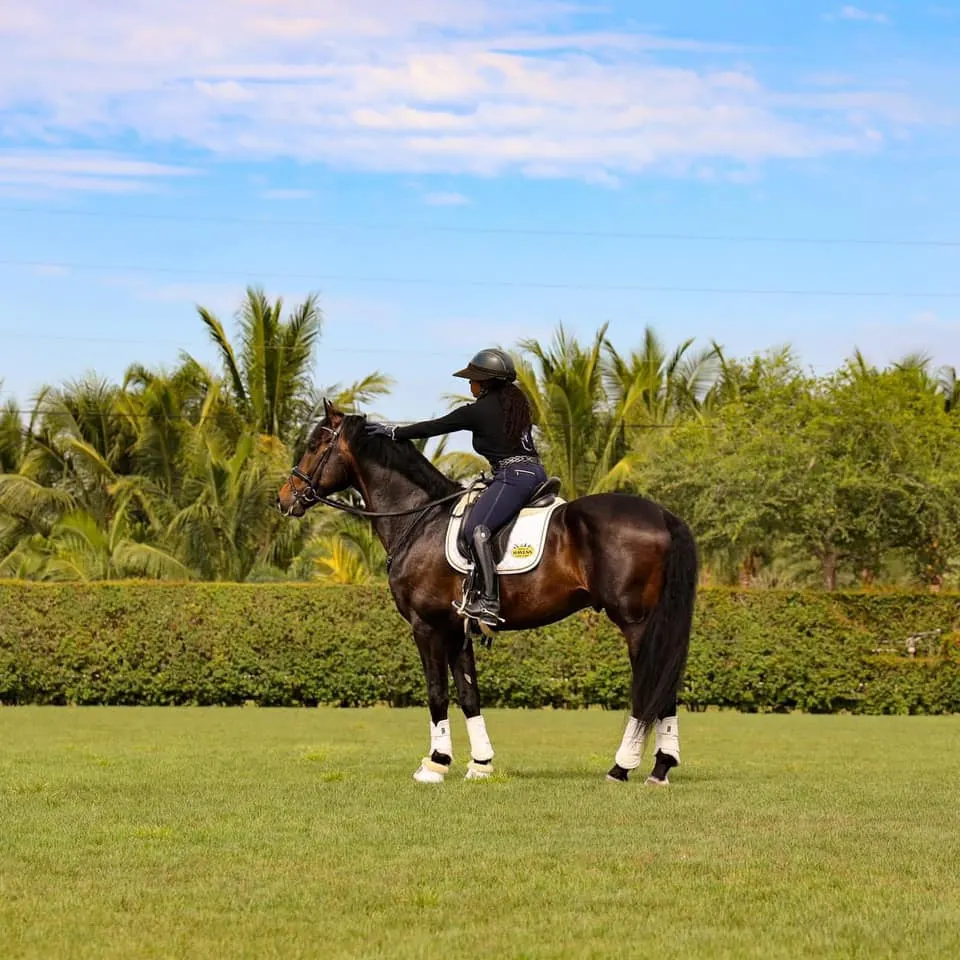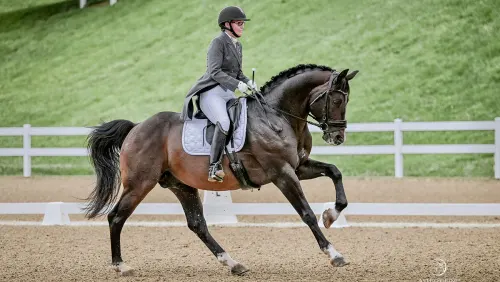As 2020 dawned, Shayna Simon knew it was time for a change.
She’d earned success in the CDI small tour ring on the West Coast with her longtime partner Harley Davidson and qualified for the national championship. But after selling “Harley,” a 15-year-old Hanoverian gelding (His Highness—Walt Lady, Walt Disney I) she’d had since he was 3, Simon packed her bags and headed to Florida to train with her remaining youngsters, and friend and student Beatrice de Lavalette.
Simon, 30, met de Lavalette while training with and working for Steffen Peters at his Arroyo Del Mar in San Diego.
De Lavalette survived the terrorist attack at the Brussels Airport in 2016, but her lower legs were amputated due to her injuries. Horses were critical to her recovery, and she became focused on para-dressage and qualifying for the Tokyo Paralympics, which meant competing in Florida was crucial.
COVID-19 derailed de Lavalette and Simon’s plans, so the pair decided to make a new start in business together, creating Equidae Dressage Stables.
We caught up with Simon to learn more about her new venture and her exciting new horse.
Why did you decide to move to Florida?
We ended up coming to Florida because Béa was [aiming] for Tokyo. I was at the point in my business where I had too many clients. It was just this redundant, ongoing thing where it didn’t seem like it was moving in the direction I wanted—too much teaching and not enough quality time with my horses. I had [Kensington TCS] at the time, and I wasn’t able to ride him some days because I was teaching from like 6 to 6. San Diego is just so expensive; it’s like you make a lot of money, spend a lot of money, type of thing.
I thought, “OK, let’s go to Florida and see how the season goes there with my horses, and see how I like it there and see how Béa does.” We’d dedicated so much already to Béa, so we thought, ‘OK, let’s go for it and see what happens.’ We went for it, and then COVID happened.
We had a little taste of what Florida had to offer, and it was addicting. There are shows every weekend, and there’s such a huge horse community. All the facilities are really close, so you can trailer to your friends’ places. It’s just built for training and showing and riding.
We all, as a group, made the decision to stay here. At the time we weren’t sure with Tokyo as well. It was one of those things where we could go home, and then all of a sudden, “Oh, you need to come back to show.” Or I could go back home and stay home, and Béa would stay here.
We ended up finding a facility [in Loxahatchee] we liked that was not far from [the Adequan Global Dressage Festival] and from White Fences and all the local facilities. We went in on that together, so now Béa and I co-own the facility.
We decided to take advantage of everything Florida has to offer and go from there. I’ve accumulated a couple more horses of my own to show and train and sell and kind of turn into more of a boutique training operation—small and really good quality.
We’re in the middle of building right now, so it’s definitely not exactly what we want at this second, but it has the roots, and it has the bones to be an amazing place. We’re super close to everything, and we’re building an eight-stall barn, so we’ll have the ability to have about 14 horses on the property, which is more than enough for us.
ADVERTISEMENT
We’ve been getting organized and getting ready for the season, because now that Tokyo’s going on, we’re going to be back at it in January.
We’re all trying to find our roles [in the business]. There’s so much that has to be done in creating a facility that you want. At the moment, I’m training all the horses, riding, structuring what we want long term, and Béa is riding and training like always and helping with the books and helping with designing and building. She likes building a lot, so she’s building boxes with flowers for the arena and building a lot of wood stuff we have.
Her mom [Elizabeth de Lavalette] is helping with the management, just our private consultant dealing with all the contractors and everything.
We’re going to try to turn this into a [USEF] Center Of Excellence, which is a para-training center, and I’ll run my business out of it. We’d like to build a couple of para horses, so when we find up-and-coming paras and people who want to be competitive in the U.S., we’ll have one or two horses that we can provide them with if they want to lease or be a part of our team.

Shayna Simon (left) and Beatrice de Lavalette are partnering together on a new business in Florida. Photo Courtesy Of Shayna Simon
It’s really hard to find good para horses, and it takes a long time to make them good because no horse is naturally going from started by a full able-bodied German man to younger girls without legs or hands or anything. They can do it, but it’s not totally natural. Béa’s so brave that we stick her on, and she’s OK, but not everybody’s like that!
Was it hard to leave the West Coast?
Yeah, it was. I’ve spent a lot of time on the West Coast, so it was kind of like a new era, but necessary for what I want to do. I’ve never been afraid to take leaps to change. When I was young I went to Europe, then went to L.A., then to Colorado. I’m used to traveling around to find what I want to do. I’m excited because this is one of the last steps for me [to find a place] that I can really call home and have a training operation that I’m proud of.
You earned your USEF silver para-equestrian training certificate last year. How did you get interested in teaching para riders?
Through Béa. I think it’s nice to work with people who have the same aspirations as you do. You run parallels through how hard you work in your daily life, working out and just doing all the things you need to do to be a top athlete. For me, I’ve found a parallel in that.
When I was teaching a lot of the amateur women, it was more of a hobby [for them], which is fine, but it’s easier for me and a little more thrilling for me to teach someone who puts the amount of work necessary into it and rides the horses that are capable of getting the scores that I want and that you’re looking for for like Olympic quality.
What are the challenges of teaching a para rider? Did you have to adapt your training style?
I think what’s the hardest is that [most of us] have our full body. Although it’s not always the correct way, we’ll use it because we have it. When you don’t have the use of your full body, you have to be a lot more educated. I think it takes a lot to teach para riders educationally so that they understand what the concepts are and what they have to achieve because they can’t really push and pull themselves to the win. Some people kind of kick and pull and get it done, and it’s not correct, but they do it. With para, they have to know exactly what they’re doing because they can’t do that. It’s great, but it’s challenging to portray all of the knowledge I’ve created over years and years into lessons to say, “OK, this is how you half-halt, and this is how you do all these things.” They can listen, but to fully understand it, it’s also academic.
What horses do you have in the barn now?
I have a 3-year-old that’s really nice and a 6-year-old stallion [Jackpot Zee T] that is going to be amazing, and my 5-year-old “King.” I have a sales horse who’s 6. I’ve really been taking my time with working out and riding my horses.
ADVERTISEMENT
I’ll clinic here and there. I’ve been learning the lay of the land and the people here, so I suspect after this season’s over I’ll find a client or two who we run parallels with and they’d like to join our facility, but for the moment I’ve been focusing on Béa and myself.
What’s Harley Davidson doing?
I sold Harley to a friend of mine, and she’s now starting from third level and moving up with him. He’s in Reno [Nevada] in a big pasture, and she rides him three or four days a week. He’s living the life.
It was [a difficult decision to sell him], but I wouldn’t have King if I didn’t. That’s kind of how I have to do things. I train them up and sell them and get something new. The longer I do this, the more quality I can purchase.

Shayna Simon trained Harley Davidson from a 3-year-old to the FEI levels. Terri Miller Photography Photo
What is King like?
He’s super nice. He’s a spicy Dutch type [Franklin—Felica], but he’s so elastic and supple and light. Every time I show him the submission scores are through the roof, which is really rare and exciting. With Harley I had to constantly fight off that he wasn’t the most supple horse, and we always had to work on making him supple, and when I got to the FEI it would hurt my scores quite a bit, so I’m excited to start FEI with [King].
He was fifth in the country and qualified for [the USEF Dressage Festival of Champions at] Lamplight [Illinois], but we decided to not take him because of COVID. Now I’m preparing for the 6-year-olds. The 6-year-old test is so complicated, so we might not do it. I haven’t made up my mind yet.
Have you been following the national conversation about diversity? What’s been your experience as a person of color in the equestrian world?
I think it’s a necessary thing, what’s going on in the world right now. There are equality issues, and I wouldn’t say it’s just black and white—it’s in a lot of things. When you’re in a sport that’s predominantly white and European and wealthy, you find those uncomfortable moments or uncomfortable situations if you are a person of color or ethnic. I haven’t personally dealt with anything horrible in the sport. I’ve dealt with racism things outside of the sport, but I haven’t dealt with anything within the sport.
I think the silence of the difference is also what keeps people kind of awkward about it, so I think just the voice of it being talked about will help a lot of ethnic riders feel more comfortable. Just the conversations—that they’re more comfortable in their own skin about being different and not caring that they’re different. Being OK with it.
Do you think you could be a role model to younger BIPOC riders coming up?
I would hope so. I’m a Black, Jewish girl, so you can’t get any more different than that! I’ve lived in Montana and Germany and now south Florida. I’ve been a lot of places where it’s not quite as accepted as southern California. I’d hope that I could be a role model for people who are scared to push themselves outside of their comfort zones. There are good people everywhere.
















